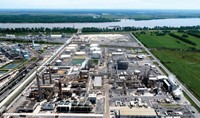Advertisement
Grab your lab coat. Let's get started
Welcome!
Welcome!
Create an account below to get 6 C&EN articles per month, receive newsletters and more - all free.
It seems this is your first time logging in online. Please enter the following information to continue.
As an ACS member you automatically get access to this site. All we need is few more details to create your reading experience.
Not you? Sign in with a different account.
Not you? Sign in with a different account.
ERROR 1
ERROR 1
ERROR 2
ERROR 2
ERROR 2
ERROR 2
ERROR 2
Password and Confirm password must match.
If you have an ACS member number, please enter it here so we can link this account to your membership. (optional)
ERROR 2
ACS values your privacy. By submitting your information, you are gaining access to C&EN and subscribing to our weekly newsletter. We use the information you provide to make your reading experience better, and we will never sell your data to third party members.
Business
Chemical makers plan blue ammonia projects
CF and LSB both unveil big plans to make the fertilizer with carbon sequestration
by Alexander H. Tullo
May 5, 2022
| A version of this story appeared in
Volume 100, Issue 16

The pace of investment in blue ammonia—ammonia made from natural gas but with carbon capture and storage—is accelerating. CF Industries and Mitsui & Co. are partnering for a new plant in the US, and LSB Industries plans to install carbon capture at its ammonia plant in Arkansas.
CF and Mitsui say their project will be “export oriented” and located on the Gulf Coast. After a study, the companies plan to make a final investment decision in 2023 and complete the plant around 2027.
CF will own 52% of the facility and will operate it. Mitsui will own the balance and market the output in Asia, where ammonia is being eyed as a low-carbon fuel. Japan aims to consume 4 million metric tons (t) per year by the end of the decade.
The plant won’t be CF’s first blue ammonia facility. The company plans to spend $200 million to install CO2 dehydration and compression capacity at its ammonia plant in Donaldsonville, Louisiana. The project will allow it to capture and sequester 2 million t of CO2 per year, making 1.7 million t of its ammonia capacity blue by 2024. CF is considering a similar, though smaller, project in Yazoo City, Mississippi. Blue ammonia is about 60% less CO2-intensive than conventional ammonia, the firm says.
CF is also installing electrolysis equipment at its Donaldsonville plant to make hydrogen from renewable power. The company will use the hydrogen to make about 20,000 t per year of so-called green armmonia starting next year.
LSB is developing a project to capture and sequester 450,000 t of CO2 annually at its plant in El Dorado, Arkansas, thereby converting 375,000 t per year of conventional ammonia to blue. Lapis Energy, a fund established by the infrastructure investment firm Cresta Fund Management, is footing the bill for the project, which is expected to be completed by 2025.
LSB, which will store the CO2 in underground saline aquifers, says its project is the third in the US—after CF’s—to use sequestration. “Our El Dorado facility is uniquely located above deep geological formations with the capacity to sequester decades of CO2 production from the plant,” CEO Mark Behrman says in a statement.
The firm expects that the emission cuts will be eligible for 45Q federal tax credits for emissions reduction. The credits will amount to $50 per metric ton of CO2 in 2026—and up to $85 if Congress implements a plan to make the credit more generous, LSB says.
Argus Media market analyst Oliver Hatfield says that despite a number of projects for blue ammonia, “there remains some uncertainty about the development of markets for this lower-carbon product.”
For example, Hatfield, says, it is unclear whether blue ammonia will get a significant price premium over conventional ammonia. It also isn’t certain if blue ammonia will meet the long-term carbon-intensity threshold for customers such as Japanese power plants, which might prefer lower-carbon green ammonia. He notes that some consumer sectors likely see blue ammonia as a transition technology to an ultimate goal of using zero-carbon or green ammonia, giving that technology time to become more competitive.



Join the conversation
Contact the reporter
Submit a Letter to the Editor for publication
Engage with us on Twitter